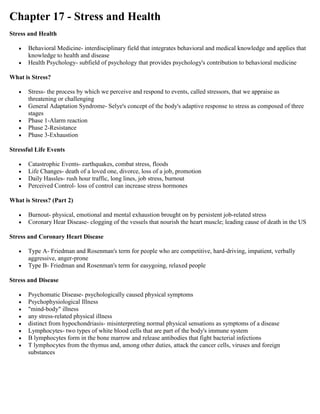Chapter 17 stress and health
- 1. Chapter 17 - Stress and Health<br />Stress and Health<br />Behavioral Medicine- interdisciplinary field that integrates behavioral and medical knowledge and applies that knowledge to health and disease<br />Health Psychology- subfield of psychology that provides psychology's contribution to behavioral medicine<br />What is Stress?<br />Stress- the process by which we perceive and respond to events, called stressors, that we appraise as threatening or challenging<br />General Adaptation Syndrome- Selye's concept of the body's adaptive response to stress as composed of three stages<br />Phase 1-Alarm reaction<br />Phase 2-Resistance<br />Phase 3-Exhaustion<br />Stressful Life Events<br />Catastrophic Events- earthquakes, combat stress, floods<br />Life Changes- death of a loved one, divorce, loss of a job, promotion<br />Daily Hassles- rush hour traffic, long lines, job stress, burnout<br />Perceived Control- loss of control can increase stress hormones<br />What is Stress? (Part 2)<br />Burnout- physical, emotional and mental exhaustion brought on by persistent job-related stress<br />Coronary Hear Disease- clogging of the vessels that nourish the heart muscle; leading cause of death in the US<br />Stress and Coronary Heart Disease<br />Type A- Friedman and Rosenman's term for people who are competitive, hard-driving, impatient, verbally aggressive, anger-prone<br />Type B- Friedman and Rosenman's term for easygoing, relaxed people<br />Stress and Disease<br />Psychomatic Disease- psychologically caused physical symptoms<br />Psychophysiological Illness<br />quot; mind-bodyquot; illness<br />any stress-related physical illness<br />distinct from hypochondriasis- misinterpreting normal physical sensations as symptoms of a disease<br />Lymphocytes- two types of white blood cells that are part of the body's immune system<br />B lymphocytes form in the bone marrow and release antibodies that fight bacterial infections<br />T lymphocytes from the thymus and, among other duties, attack the cancer cells, viruses and foreign substances<br />Promoting Health<br />Aerobic Exercise- sustained exercise that increases heart and lung fitness; may also alleviate depression and anxiety<br />Biofeedback- system for electronically recording, amplifying, and feeding back information regarding a subtle physiological state<br />Blood pressure<br />Muscle tension<br />Prevention<br />14% of US Gross Domestic Product is spent on health care<br />2/3 of organizations with less than 50 employees have health promoting programs<br />health assessments<br />fitness training<br />smoking cessation<br />stress management<br />Smoking<br />Some estimations show smoking kills about 20 loaded jumbo jets per day<br />Smoking is a pediatric disease<br />Rebellious youth<br />Modeling behavior, social rewards<br />Targeted ad campaigns<br />Why not quit? Nicotine delivery system<br />How to Quit<br />Education<br />Eliminate the social reinforcement<br />Increase social support for quitting<br />Cost<br />Tax it to shorten the time between behavior and punishment<br />Reduces smoking by 4% for every 10% increase cost<br />Nicotine Replacement -Patch and Gum<br />Reduce pharmacological addiction<br />Then treat psychological addiction<br />

